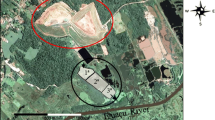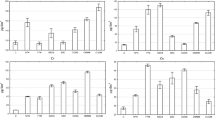Abstract
In less populated rural areas constructed wetlands with a groundfilter made out of the local soil mixed with peat and planted with common reed (Phragmites australis) are increasingly used to purify waste water. Particularly in the rhizosphere of the reed, nitrification and denitrification processes take place varying locally and temporally, and the question arises to what extent this type of waste-water treatment plant may contribute to the release of N2O. In situ N2O measurements were carried out in the two reed beds of the Friedelhausen dairy farm, Hesse, Germany, irrigated with the waste water from a cheese dairy and 70 local inhabitants (12 m3 waste water or 6 kg BOD5 or 11 kg chemical O2 demand (CODMn) day–1). During November 1995 to March 1996, the release of N2O was measured weekly at 1 m distances using eight open chambers and molecular-sieve traps to collect and absorb the emitted N2O. Simultanously, the N2O trapped in the soil, the soil temperature, as well as the concentrations of NH4 +-N, NO3 –-N, NO2 –-N, water-soluble C and the pH were determined at depths of 0–20, 20–40 and 40–60 cm. In the waste water from the in- and outflow the concentrations of CODMn, BOD5, NH4 +-N, NO3 –-N, NO2 –-N, as well as the pH, were determined weekly. Highly varying amounts of N2O were emitted at all measuring dates during the winter. Even at soil temperatures of –1.5 °C in 10 cm depth of soil or 2 °C at a depth of 50 cm, N2O was released. The highest organic matter and N transformation rates were recorded in the upper 20 cm of soil and in the region closest to the outflow of the constructed wetland. Not until a freezing period of several weeks did the N2O emissions drop drastically. During the period of decreasing temperatures less NO3 –-N was formed in the soil, but the NH4 +-N concentrations increased. On average the constructed wetlands of Friedelhausen emitted about 15 mg N2O-N inhabitant equivalent–1 day–1 during the winter period. Nitrification-denitrification processes rather than heterotrophic denitrification are assumed to be responsible for the N2O production.
Similar content being viewed by others
Author information
Authors and Affiliations
Additional information
Received: 28 October 1998
Rights and permissions
About this article
Cite this article
Fey, A., Benckiser, G. & Ottow, J. Emissions of nitrous oxide from a constructed wetland using a groundfilter and macrophytes in waste-water purification of a dairy farm. Biol Fertil Soils 29, 354–359 (1999). https://doi.org/10.1007/s003740050565
Issue Date:
DOI: https://doi.org/10.1007/s003740050565




